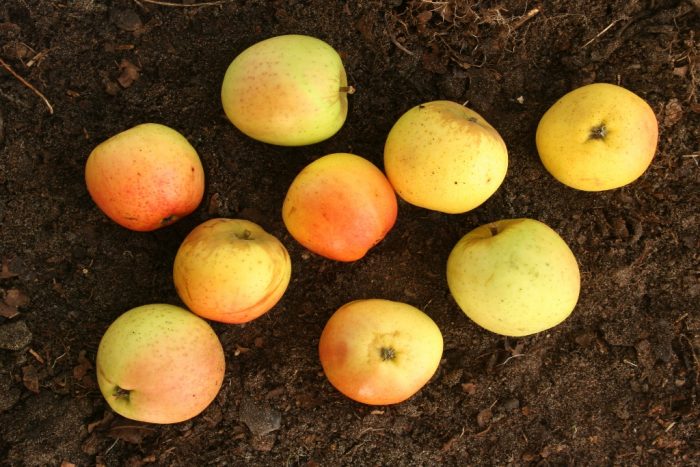
By Suzanne Wynn, writing from her home in the apple county of Somerset:
Apples are our national fruit, yet I wonder how many people feel excited by them? Community Orchards and events such as Apple Day get people reconnected with this fruit.
Apples are our national fruit, yet I wonder how many people feel excited by them? Living in Somerset as I do, apples are not only our national fruit but also, particularly when made into cider, our county fruit, but even here they don’t always generate the excitement that they deserve. Are they just a boring staple of the fruit bowl or lunch box? If you buy them in a supermarket, then I bet they are.
The Farmers Weekly used the occasion of the Labour Party conference to draw attention to the low price paid to farmers for various British produce. Of apples, they asked how much profit the farmer could expect to receive on a bag of apples that had cost the farmer 76p to produce. The correct answer of 3p was far lower than anyone had guessed.
Of course, I want farmers to be paid a fair price for what they produce and for our country to produce a much larger proportion of the food it consumes. But the answer, at least as far as apples are concerned, is to shorten the chain between producer and consumer, in fact apples are a prime candidate for a people’s takeover, something I have actively been championing for years. I don’t really see why we need to be importing apples at all, and certainly not between the months of August to February. However, the industry has responded to the apparent consumer desire to consume apples year-round by controlling not only the temperature but also the gasses present in the storage environment. Supermarkets will bring a different variety out of storage each month thereby destroying any notion of true seasonality. However, as many people will have found, once removed from their rarified environment, these apples don’t ripen very well in the fruit bowl, with both the texture and flavour proving disappointing. I actually find the sight of supermarket apples, unblemished and uniformly sized and shaped, a bit creepy. I have sometimes wondered whether the shiny apples displayed in hotel lobbies were real or made of wax. It takes a lot of chemical spraying to get apples looking like this, and they make me feel homesick rather than welcomed. Apple characteristics vary through the seasons, with the best flavour, in my opinion, developing late in the season. My absolute favourite is an Ashmead’s Kernel although it has to be admitted that it is not much of a looker, with a matt russet skin – definitely not something you polish. The flavour, however, is exquisitely complex, with a hint of pear drops. It isn’t fully ripe until the end of November, so it is necessary to have picked them in October and then ripen further in a cool store. I can usually continue eating them until towards the end of January. Other’s will swear that you can’t beat the flavour of an apple eaten straight from the tree. Judging the perfect point is the critical thing, and the earlier the apple the shorter the window in which to enjoy it. When you get this right, you are sure to find that apples are indeed something worth shouting about. If you have access to a tree, you will soon learn when they are at their best. Alternatively, you can buy traditional varieties direct from producers such as www.charltonorchards.com. A box of winter apples is a wonderful gift, providing you know that the recipient has somewhere cool to keep them.
Storing apples at home used to be common practice before people had central heating. Nowadays you probably need a cool outhouse – a shed or garage. Storage is the main thing we pay the supermarkets to do, but the true cost of handing over this task is far greater than the price we see on the ticket. With more natural temperature controlled storge it is really only possible to keep the last apples until March, and those are really only for cooking. Damaged apples can’t be kept, so it is necessary to find alternative uses for this portion of your crop – apple juice is a popular solution.
Developing varieties specifically for cooking is a peculiarly British trait and as we eat fewer cooked puddings than of old these have become less popular. Bramley apples are probably the only cooking variety that most people can name, and commercially these are picked in August, whilst they are still very sharp and green. The acidity in an apple affects the way that it cooks. The flesh of a Bramley Apple will break down completely, ideal for a sauce but frustrating if you wanted the apple to hold its shape. Britain has a wide range of cooked apple desserts which evolved to make the best of the characteristics of different varieties through the seasons although you will struggle to buy anything other than a Bramley now and so these dishes also face extinction. Our Community Orchard has a very old cooking variety, Catshead, the earliest reference to it being 1629. It is very large, green and with an angular conical shape, some say reminiscent of a cat’s head, but it is also sometimes known as Pig’s Snout. The flesh is less sharp and much drier than a Bramley so that, although it would eventually break down to a firm purée, it is more usually baked whole, often wrapped in pastry to make an Apple Dumpling.
You will also struggle to find any of the traditional “dual varieties”, which have some of the sharpness necessary to ensure the apple flavour comes through no matter how many other spices or flavours are added to a recipe, but at the same time can hold a slice when cooked rather than dissolving into a mush. Any recipe described as “Somerset” indicates that the meat (e.g., pork or pheasant) has been cooked in cider along with slices of apple and finished with cream. Don’t bother trying to use Bramley apples in these recipes. I often add rings of apple that I have dried myself, although whenever I see dried apple for sale it comes from China, so the alternative is to fry slices of dessert apple in butter and add them at the end in order to keep them whole.
Somerset adds apples to dishes whenever it can, and recently I couldn’t resist an Apple Bread Pudding seen in a traditional bakery. Bread Pudding used to be made by bakers everywhere as a way of using up any leftover bread which is soaked in tea with added dried fruit and then recooked. The apple addition lifted this homely dish to another level, reminding me how seldom Bread Pudding is found nowadays and determined to find some “leftover” bread even if it meant baking more in the first place!
As I have already said, many dishes came into being as a way to use up apples and to store them for the future, fruit chutney being one example that has survived well. When I replanted our old orchard, I tried to include as many local heritage varieties as possible and one of these is called Golden Knob. It is a very small apple, of a size that could easily be held in a child’s hand (hence the name, in case you had other ideas). The trouble is these apples are too small to be of much use. I did try pressing them for juice one year but the high proportion of core to fruit didn’t make this option very successful. Then I found an old Cornish recipe for Sweet Larks, the Sweet Larks being another small dessert variety but the size making them perfect for pickling whole. Pickling is enjoying a big resurgence at the moment, pickled vegetables seem almost compulsory on restaurant menu, but I have yet to see pickled apples. They are definitely worth trying if you have some fruit small enough to preserve whole.
Apple Day was initiated by Common Ground in 1990 as part of their drive to reinvigorate interest in orchards. It takes place on 21st October, which we find marks a handy close to the harvesting, before the days shorten, the winds pick up and the first frosts are felt. It is not by any means the end of the season for eating apples and the work is really only just starting for those making cider, but most fruit for eating needs to be picked by then.
I have been involved with promoting orchard fruit pretty much since Apple Day was first started and the community orchard in our village provides a focal point for our activities. In truth, this hasn’t been a brilliant year for apples, the trees set plenty of fruit in spring but then the cold summer didn’t help them grow, nor it appears, did the natural shedding of surplus fruitlets occur in June. Unless you carried out thorough thinning by hand, you were probably left with too many small fruits. Over the years we have shared knowledge and resources and I have been delighted with the response to my request for orchard produce for a bring and buy sale in aid of Ukraine which I hoped would make up for a lack of apples on Apple Day. We have fresh walnuts and medlars plus an array of preserves from Plum Jam (plums did crop well this year) to hedgerow jellies including Bullace (wild damsons) and Rowan, plus apple and pear chutneys. I’m very satisfied that in this corner of Somerset the orchard traditions are strong, and I know that we are not the only place where this is happening. Happy Apple Day!
Pickled Sweet Larks
(Traditional Recipe from Common Ground’s Apple Source Book)
1 quart of malt vinegar
2 lbs. sugar
Cloves
1 clean sample of sweet larks
Scoop the eyes out of the apples and replace with one or two cloves in each socket.
Gently heat the vinegar adding the sugar until it is dissolved and then bring it to the boil. Add the apples and simmer until the flesh is just softening.
Place the apples gently in the pickling jar and cover with the remaining syrup. Store with a closed top.
Eat with bread and butter and perhaps, cream.
More from Suzanne Wynn can be found on Colin Tudge’s ‘Great Re-Think’ website: www.colintudge.com





